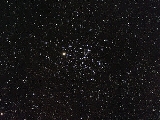
Butterfly Cluster
Encyclopedia
The Butterfly Cluster is an open cluster
of star
s in the constellation of Scorpius
. Its name derives from the vague resemblance of its shape to a butterfly
.
The first astronomer to record the Butterfly Cluster's existence was Giovanni Battista Hodierna
in 1654. However, Robert Burnham, Jr has proposed that the 1st century astronomer Ptolemy
may have seen it with the naked eye while observing its neighbor the Ptolemy Cluster
(M7). Charles Messier
catalogued the cluster as M6 in 1764. It was not till the 20th century that star counts, distance, and other properties were measured.
, BM Scorpii, which contrasts sharply with its blue neighbours in photographs. BM Scorpii, is classed as a semiregular variable star
, its brightness varying from magnitude
+5.5 to magnitude +7.0.
Estimates of the Butterfly Cluster's distance have varied over the years, with a mean value of around 1,600 light years, giving it a spatial dimension of some 12 light years. Modern measurements show its total visual brightness to be magnitude 4.2.
Open cluster
An open cluster is a group of up to a few thousand stars that were formed from the same giant molecular cloud and have roughly the same age. More than 1,100 open clusters have been discovered within the Milky Way Galaxy, and many more are thought to exist...
of star
Star
A star is a massive, luminous sphere of plasma held together by gravity. At the end of its lifetime, a star can also contain a proportion of degenerate matter. The nearest star to Earth is the Sun, which is the source of most of the energy on Earth...
s in the constellation of Scorpius
Scorpius
Scorpius, sometimes known as Scorpio, is one of the constellations of the zodiac. Its name is Latin for scorpion, and its symbol is . It lies between Libra to the west and Sagittarius to the east...
. Its name derives from the vague resemblance of its shape to a butterfly
Butterfly
A butterfly is a mainly day-flying insect of the order Lepidoptera, which includes the butterflies and moths. Like other holometabolous insects, the butterfly's life cycle consists of four parts: egg, larva, pupa and adult. Most species are diurnal. Butterflies have large, often brightly coloured...
.
The first astronomer to record the Butterfly Cluster's existence was Giovanni Battista Hodierna
Giovanni Battista Hodierna
Giovanni Battista Hodierna was an Italian astronomer at the court of the Duke of Montechiaro. He compiled a catalog of some 40 entries, including at least 19 real and verifiable nebulous objects that might be confused with comets. The work anticipated Messier's catalogue, but had little impact...
in 1654. However, Robert Burnham, Jr has proposed that the 1st century astronomer Ptolemy
Ptolemy
Claudius Ptolemy , was a Roman citizen of Egypt who wrote in Greek. He was a mathematician, astronomer, geographer, astrologer, and poet of a single epigram in the Greek Anthology. He lived in Egypt under Roman rule, and is believed to have been born in the town of Ptolemais Hermiou in the...
may have seen it with the naked eye while observing its neighbor the Ptolemy Cluster
Ptolemy Cluster
Messier 7 or M7, also designated NGC 6475 and sometimes known as the Ptolemy Cluster, is an open cluster of stars in the constellation of Scorpius....
(M7). Charles Messier
Charles Messier
Charles Messier was a French astronomer most notable for publishing an astronomical catalogue consisting of deep sky objects such as nebulae and star clusters that came to be known as the 110 "Messier objects"...
catalogued the cluster as M6 in 1764. It was not till the 20th century that star counts, distance, and other properties were measured.
Characteristics
Most of the bright stars in this cluster are hot, blue B type stars but the brightest member is a K type orange giant starGiant star
A giant star is a star with substantially larger radius and luminosity than a main sequence star of the same surface temperature. Typically, giant stars have radii between 10 and 100 solar radii and luminosities between 10 and 1,000 times that of the Sun. Stars still more luminous than giants are...
, BM Scorpii, which contrasts sharply with its blue neighbours in photographs. BM Scorpii, is classed as a semiregular variable star
Variable star
A star is classified as variable if its apparent magnitude as seen from Earth changes over time, whether the changes are due to variations in the star's actual luminosity, or to variations in the amount of the star's light that is blocked from reaching Earth...
, its brightness varying from magnitude
Apparent magnitude
The apparent magnitude of a celestial body is a measure of its brightness as seen by an observer on Earth, adjusted to the value it would have in the absence of the atmosphere...
+5.5 to magnitude +7.0.
Estimates of the Butterfly Cluster's distance have varied over the years, with a mean value of around 1,600 light years, giving it a spatial dimension of some 12 light years. Modern measurements show its total visual brightness to be magnitude 4.2.
See also
- Messier ObjectMessier objectThe Messier objects are a set of astronomical objects first listed by French astronomer Charles Messier in 1771. The original motivation of the catalogue was that Messier was a comet hunter, and was frustrated by objects which resembled but were not comets...
- List of Messier objects
- List of open clusters
- New General CatalogueNew General CatalogueThe New General Catalogue of Nebulae and Clusters of Stars is a well-known catalogue of deep sky objects in astronomy. It contains 7,840 objects, known as the NGC objects...

